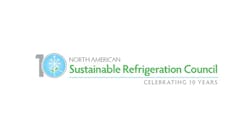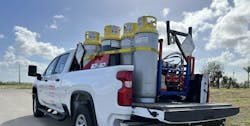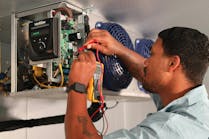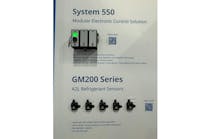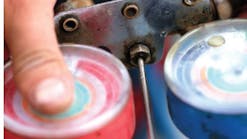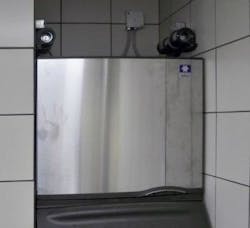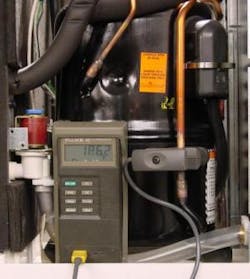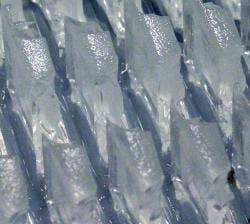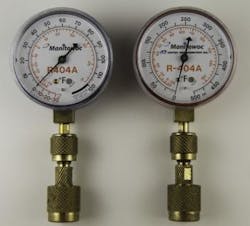The following tips will help service technicians quickly narrow down the problem on ice machine service calls.
But first, here are the basic tools you need to have when you walk in the customer’s door:
• the service manual for the ice machine (if you know the ice machine model number, you can access the manual from the manufacturer’s website).
• thermometer
• screwdriver to remove panels
• refrigeration scale to weigh ice
• a smile and an air of confidence to put the customer at ease.
It looks impressive to carry in that manifold gauge set and brightly colored refrigerant cylinder, but you probably won’t need them. The majority of machine problems can be corrected without ever connecting your manifold gauge set.
Ice machines may experience operational problems only during certain times of the day or night. A machine may function properly while it is being serviced, but malfunctions later. Information provided by the customer can help the technician start in the right direction, and may be a determining factor in the final diagnosis.
Initial Check
Determine if the ice machine has been installed with the correct clearances, electrical requirements and drains. Bad installations result in service calls and upset customers. Check the installation use and care manual to verify that everything is correct. (See Photo 1)
Critical Questions
To help make the proper diagnosis, ask your customers the following questions to obtain important information:
1. When does the ice machine malfunction? Is it during the night, day, and all the time?
2. When does the customer notice low ice production? Is it one day a week, every day, on weekends?
3. Can the customer describe exactly what the ice machine seems to be doing?
4. Has anyone been working on the ice machine?
5. Is anything such as boxes or plastic bags usually stored near or on the ice machine and obstructing airflow around the machine? Often the customer will clean up the area for you before you arrive.
6. During store shutdown is the circuit breaker, water supply or air temperature altered?
7. Is there any reason why incoming water pressure might rise or drop substantially?
Also, make it a habit to determine the following during your service call:
• Is it following the correct electrical sequence of operation?
• Is the air-cooled condenser or filter dirty?
• Is the water filter plugged, or the water area (evaporator) dirty?
• Are there signs of water loss? A water-related problem often causes the same symptoms as a refrigeration problem.
Sequence of Operation
Verify that the ice machine is able to initiate a freeze and harvest cycle. If any of the following are observed, then refer to the service manual for model specific diagnostics:
• the ice machine doesn’t run
• the freeze cycle is interrupted before ice has formed
• a harvest cycle is never started
• the harvest cycle terminates before completion.
The operational sequence must be normal before you perform additional diagnostics.
Production Check
The amount of ice produced is directly related to the water and air temperature. An ice machine in a 70F room and 50F water produces more ice than the same model ice machine in a 90F room with 70F water. Determine the air temperature entering the condenser and the water temperature entering the sump trough. Then check the ice
What would be the result if you spent four hours getting 10%
more ice production, and the customer's ice scooper
still hits the bottom of the bin?
production (the manufacturer’s service manual will outline the procedure). If the actual production is within 10%, stop and ask yourself this question: If I can get 10% more production will it be enough to fill my customer’s needs? You would be better off to offer solutions such as more storage capacity, another ice machine or relocating the existing ice machine to a cooler area. What would be the result if you spent four hours getting 10% more ice production, and the customer's ice scooper still hits the bottom of the bin?
Ice Formation Pattern
Any number of problems can cause improper ice formation. There are four basic ice fill patterns: normal, thin at the evaporator outlet, thin at the evaporator inlet, and no ice on the evaporator.
A normal ice fill pattern covers the entire evaporator surface. The length of the freeze cycle does not count — even when the length of the freeze cycle is double or triple, the fill pattern is still considered normal.
- Thin at the evaporator outlet is a starving condition and can be caused by a hot water supply, water escaping the sump trough/water circuit, a faulty water fill valve or low refrigerant charge.
- Thin at the evaporator inlet is a flooding condition. The expansion valve insulation and sensing bulb mounting must be checked carefully.
- No ice on the evaporator can be caused by a substantial loss of refrigerant or the expansion valve-sensing bulb losing its charge.
Safety limits
In addition to standard safety controls, such as a high-pressure cutout, manufacturers build safety limits into the control board to protect the ice machine from major component failures. Check the ice machine front cover label or the service manual for instructions on recalling and reading the code in the board.
Is it a Freeze Cycle or Harvest Problem?
Is the freeze cycle okay? You must have a good freeze cycle to have a good harvest cycle. The compressor develops heat throughout the freeze cycle. This heat is used to support harvest cycle pressures. Lack of heat in the freeze cycle will result in a harvest problem.
Before diagnosing harvest problems, verify that the freeze cycle is operating correctly.
Before diagnosing harvest problems, verify that the freeze cycle is operating correctly. Check the discharge line temperature. Knowing if the discharge line temperature is increasing, decreasing or remaining constant can be an important diagnostic tool.
Compressor discharge line temperature on a normally operating ice machine steadily increases throughout the freeze cycle. Ambient air temperature also affects the maximum discharge line temperature. (See Photo 2) Higher ambient air temperatures at the condenser equal higher discharge line temperatures at the compressor. Lower ambient air temperatures at the condenser equal lower discharge line temperatures at the compressor.
Compare the temperatures over several cycles and a pattern will emerge. Regardless of ambient temperature, the discharge line should be hot enough to leave burns on your forearm.
Mechanical or Refrigeration Problem?
Ice-release issues fall into two main categories: mechanical or refrigeration. The first step in solving an ice-release issue is to determine which condition exists. A quick test is to wait until the end of the harvest cycle, place the toggle switch in the off position and then remove and inspect the ice slab (no screwdrivers please).
• If the cubes are well defined and show no signs of melting, a refrigeration problem is indicated.
• If the cubes are deformed and melted away, a mechanical problem is indicated.
Mechanical problems commonly involve a dirty evaporator. Dry the evaporator before inspecting for cleanliness. Dirty evaporators account for more release problems than all other problems combined. Clean the evaporator before proceeding.
Another source of a mechanical problem might be a damaged evaporator. Inspect the evaporator for physical damage caused by a screwdriver, ice pick, hammer or improper cleaners.
Refrigeration problems during the freeze cycle could be indicated by a cold compressor and cool discharge line. Some probable causes are a flooding expansion valve (check bulb insulation and bulb mounting) or low head pressure (low ambient only).
Check the water-regulating valve on water-cooled models, the fan cycling control on air-cooled models and the head-pressure regulating valve on remote-condenser models. At ambient temperatures above 75F the head pressure-regulating valve on remote models will not be the problem.
Low harvest suction pressure could indicate refrigeration problems during harvest. It’s possible the harvest valve or the harvest pressure-regulating valve (remotes only) did not open. This is a short list, if you don’t see the problem go back and thoroughly clean the evaporator with a brush and recheck the freeze cycle.
If You Still Haven't Found the Problem
If you still haven’t found the problem, it’s time to get the manifold gauges — and not the one with the 6-ft. hoses. Remember: ice machines have a critical refrigerant charge and gauges with short stubs must be used. Zero out your gauges and connect to the access valves on the ice machine.
Analyzing Refrigerant Pressure
You already determined the ice machine operating conditions (the air temperature entering the condenser and the water temperature entering the sump trough). Use the operating conditions to determine the manufacturer’s normal discharge pressures.
The discharge pressure is normal when the actual pressure falls within the published pressure range for the ice machine’s operating conditions. Analyze the discharge pressure before analyzing suction pressure. High or low discharge pressure may cause high or low suction pressure.
Low discharge pressure can be caused by improper water supply over the evaporator (no load), a starving expansion valve or a restricted/plugged liquid line drier.
High discharge pressure can be caused by a dirty condenser, noncondensable gas in the system (air), a defective fan motor, refrigerant overcharge, wrong type of refrigerant or a harvest valve that doesn’t closed completely.
The suction pressure gradually drops throughout the freeze cycle. The actual suction pressure (and drop rate) changes as the air and water temperatures entering the ice machine change. This affects the freeze cycle time. To analyze and identify the proper suction pressure drop throughout the freeze cycle, compare the published suction pressure to the published freeze cycle time.
These procedures, with a little practice, will help you narrow down the causes of ice machine failure.
Mitch Rens is the Service Publications Manager for the Ice Machine Division of Manitowoc Foodservice. manitowocice.com
